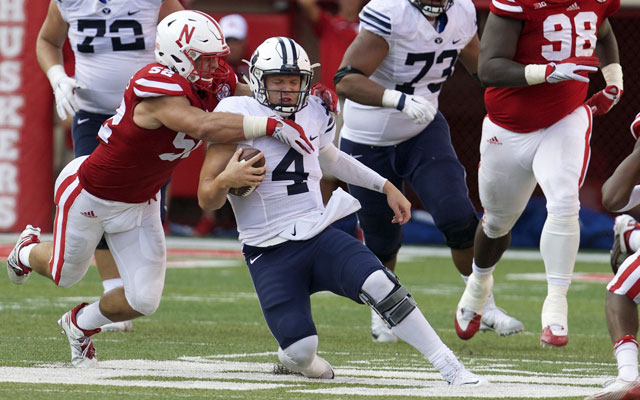
In another age, they simply would have amputated Taysom Hill’s foot.
That’s what they did in Napoleon’s time when cavalry troops falling off their horses got their feet caught in stirrups.
“It would violently dislocate your foot,” said Chad Lewis, both an NFL veteran and -- as we shall see -- an expert on the injury. “Couldn’t do anything but cut off your forefoot and give you a stump.”
Two-hundred years removed from that gruesome era, in a University of Nebraska trainer’s room last September, Hill -- BYU’s quarterback -- knew little of that history.
It was opening day, a new day for Hill, who had fought off two previous season-ending injuries to put himself in position to finish his career right in 2015.
For starters, "right" meant healthy.
Up until a point in the second quarter, Hill had recaptured the form that at one time made him arguably the best running quarterback in the country.
Three seasons ago, Hill ran for 259 yards and three touchdowns in a humiliation of Texas. He entered 2015 as the only active 2,000-yard career rusher and 4,000-yard passer.
“I wanted to be out there with my guys,” Hill told CBS Sports. “Being a senior and having them vote you team captain, I wanted to be out there so desperately. I was so looking forward to the upcoming season.”
But Hill went down during that second quarter, and a quick diagnosis in that trainer’s room confirmed the worst: Hill had suffered that 200-year-old injury. They even had a name for it: "Listfranc," after the French surgeon who performed the battlefield amputations.
Technically, Hill had dislocated a bone or bones on the top of his foot. Gloriously, he had done it running for a second-quarter touchdown against the Huskers. Realistically, BYU medical officials were quickly telling him he was done for the season. Again.
“I knew what it was the second it happened,” Lewis said.
Of course he did. Lewis, BYU’s associate athletic director in charge of development, is a former Cougars tight end who basically had his nine-year NFL career ended by a Lisfranc injury he suffered after catching a touchdown pass for the Eagles in the 2005 NFC Championship Game.
As he came down with the ball, Lewis felt and heard the “pop” so familiar with Lisfranc.
“Two minutes before the Super Bowl [berth was clinched],” he said.
Lewis knew the long, painful rehab that was ahead for Hill, and he knew it could last 6-9 months. Lewis knew there would be days during that rehab Hill felt like he was walking on glass. There would be encouraging periods of progress, then excruciating pain when Hill would feel like he wouldn’t walk again.
“You have no idea how hard it was for him,” Lewis explained.
Somebody, somewhere had to be messing with this Hill. He had suffered the hat trick of season-ending injuries. His freshman season was ended in 2012 when Hill blew out his knee. Incredibly, two years later, the same Utah State player hit him again and broke his ankle.
“Can you imagine?” Lewis asked rhetorically. “The planets aligned in the most perverse way possible.
“His first game back [at Nebraska], tearing up a good team on national TV. Steve Young is watching this in San Francisco saying to himself, ‘He cannot be stopped.’"
Lewis still marvels that the quarterback ran for that 21-yard touchdown “with a popped Lisfranc.” What Lewis didn’t know: Hill season would soon be over, but his game was not.
The pain eventually would eventually become unbearable at some point that day, Hill was told. With the juices still flowing at halftime, with his career flashing before him, the senior quarterback had to ask the question: Can I go back in?
“You can’t hurt yourself any more now,” BYU AD Tom Holmoe recalled doctors telling the quarterback.
Tape me up, Hill said. Let’s go.
At that moment, even a debilitating injury wasn’t going to slow him. Hill played all of the third quarter and one play into the fourth quarter knowing it was his last action of the season, perhaps his career.
“That’s accurate,” Hill said. “I knew that this was going to be it, so I was going to go as long as I could.”
Never mind Hill had a secure future as a financial whiz. Never mind the philosophical argument of a scholarship being enough for college athletes. Hill had literally, knowingly sacrificed his body -- and wanted more.
Injuries are part of the game. Hill played those 13 second-half snaps soaking up everything for perhaps one last time. He had fallen head over spikes in love with the game that kept trying to ruin him.
“You can’t replicate the experience of being out there playing in front of 100,000 on national television,” Hill explained, “with the guys you spend so much time with. There’s a short window during which you can compete at that level.”
It was both inspiring and tragic closure. Three season-ending injuries. That had to be it for his career, right?
“It’s a great story but it’s not written,” Holmoe said. “The ending hasn’t been written yet.”
Hill had options. One of them was to enter the workforce. He already had set himself up nicely. A couple of years ago, Hill had completed a New York internship with a venture capital firm. In January, he began a full-time job managing a Provo-based trust fund.
Who needed the aggravation of one more full-fledged rehabilitation? And even if Hill decided to go through that struggle, he might as well get paid for it. The NFL was a possibility after rehab. Certainly there was a starting job waiting him for him somewhere in college as a graduate transfer. That would have been logical, too.
Former BYU coach Bronco Mendenhall wanted him at Virginia. Quarterback-starved Texas would have taken him.
“I told him after he got hurt, ‘Taysom, you can do whatever you want,’ Holmoe said. “You want to go to Wall Street? You want to go to the NFL? Go.”
Amazingly, Hill stayed in Provo, Utah.
He stayed at BYU despite being good friends with Chris Collinsworth, a former Cougars basketball forward who had three season-ending injuries himself. “He misses it like crazy,” Hill said. “That was really [impactful] to me.”
Hill stayed despite the plight of his brother-in-law, Craig Bills, the former BYU safety who signed as a free agent with the Eagles last year.
“The next day he wakes up and can’t even walk,” Lewis said. “The Eagles cut him and said, ‘When you’re healthy, call us.’"
Another Lisfranc injury.
Staying was probably the worse option of all. Unless, of course, you’re in love.
“I can work and I will work the rest of my life,” Hill said. “There’s a short window of opportunity [to play].”
To reinforce Hill’s decision, Lewis set up a meeting with Kansas City Chiefs coach Andy Reid and trainer Rick Burkholder. Lewis knew both from his days with the Eagles, and BYU just happened to be playing a November game against Missouri at Arrowhead Stadium.
“I wanted to put Taysom’s mind at ease,” Lewis said. “The message was, ‘You still have everything in front of you. This doesn’t finish anything.’"
Hill stayed at BYU, intentionally delaying his graduation until May to have one more year of eligibility. To do so, Hill’s entire course load this semester is a half-credit class called Intercollegiate Athletics.
Before getting that finance degree, he is absolutely majoring in football getting credit for workouts and practices.
It’s all been vetted by the NCAA. But the question remains: Why come back at all?
“Ultimately, this is my home. I’m a BYU,” Hill explained. “I was pretty certain I was making the best decision for myself …
“My mentality is, there are freak injuries and I was unlucky. I’ll rehab and I’ll get better. I’ve done it twice before.”
We should all be so sanguine. Hill stayed despite what is now a competition with the player who replaced him that day at Nebraska.
Tanner Mangum had a fine freshman season, throwing for 23 touchdowns. His first touchdown toss was a highlight-making Hail Mary to beat the Huskers. In his first start the following week, Mangum threw another Hail Mary to beat Boise State. For a few fleeting moments there, he was a national feel-good story while Hill had nothing to do but feel bad.
Competition? It’s not even that at the moment. Hill is still in the hell of rehab, not a full-go yet in spring practice.
“You throw the word ‘competition’ around and it has a negative connotation,” said Hill, now a fifth-year senior.
“The nice thing is we have time. We’re not in a big hurry. Our whole mindset is for September.”
Again.





















